Blog & Latest Updates
Fly Fishing Articles
Insects by Common Name


Updates from May 6, 2007
Photos by Troutnut from the Beaverkill River in New York
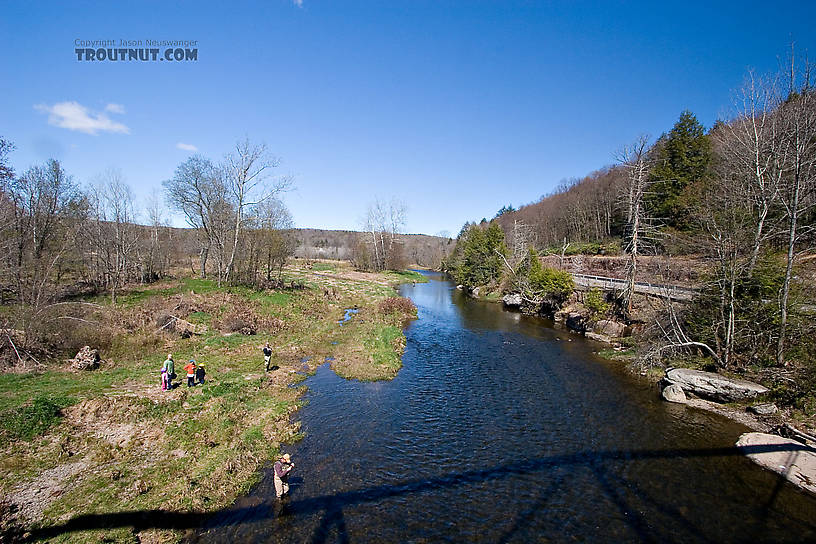
This popular Catskill stream was a bit crowded on one of the prime days of the Hendrickson hatch.
StateNew York
LocationBeaverkill River
Date TakenMay 6, 2007
Date AddedJun 5, 2007
AuthorTroutnut
CameraCanon EOS 20D
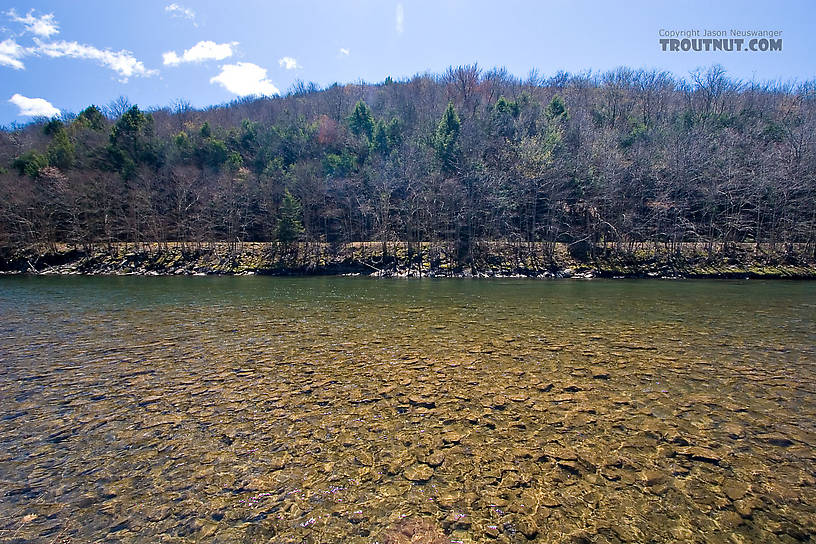
StateNew York
LocationBeaverkill River
Date TakenMay 6, 2007
Date AddedJun 5, 2007
AuthorTroutnut
CameraCanon EOS 20D
Closeup insects by Troutnut from the Neversink River, Mongaup Creek, Miscellaneous New York, and Mystery Creek #62 in New York
Baetisca obesa (Armored Mayfly) Mayfly Nymph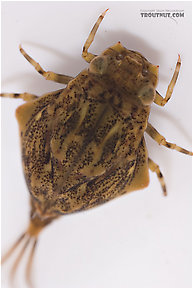 View 12 Pictures
View 12 Pictures
 View 12 Pictures
View 12 PicturesCollected May 6, 2007 from the Neversink River (above reservoir) in New York
Added to Troutnut.com by Troutnut on May 10, 2007
Added to Troutnut.com by Troutnut on May 10, 2007
Pteronarcys biloba (Knobbed Salmonfly) Stonefly Nymph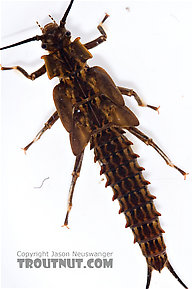 View 17 Pictures
View 17 Pictures
 View 17 Pictures
View 17 PicturesCollected May 6, 2007 from the Neversink River (above reservoir) in New York
Added to Troutnut.com by Troutnut on May 10, 2007
Added to Troutnut.com by Troutnut on May 10, 2007
Baetis (Blue-Winged Olives) Mayfly Nymph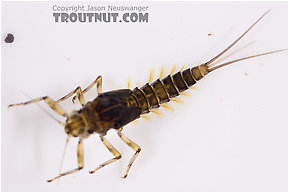 View 10 Pictures
View 10 Pictures
 View 10 Pictures
View 10 PicturesCollected May 6, 2007 from Mongaup Creek in New York
Added to Troutnut.com by Troutnut on May 18, 2007
Added to Troutnut.com by Troutnut on May 18, 2007
Acroneuria abnormis (Golden Stone) Stonefly Nymph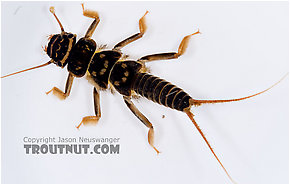 View 12 Pictures
View 12 Pictures
 View 12 Pictures
View 12 PicturesCollected May 6, 2007 from Mongaup Creek in New York
Added to Troutnut.com by Troutnut on May 18, 2007
Added to Troutnut.com by Troutnut on May 18, 2007
Epeorus (Little Maryatts) Mayfly Nymph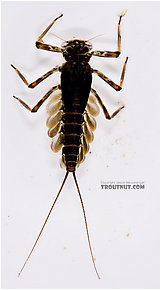 View 9 Pictures
View 9 Pictures
 View 9 Pictures
View 9 PicturesCollected May 6, 2007 from Mongaup Creek in New York
Added to Troutnut.com by Troutnut on May 18, 2007
Added to Troutnut.com by Troutnut on May 18, 2007
Paragnetina (Golden Stones) Stonefly Adult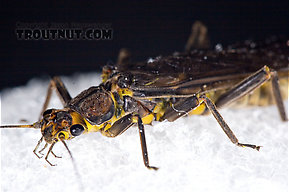 View 10 PicturesUnfortunately I forgot to photograph this one next to the ruler, but I seem to remember it being on the small side for a Perlid, maybe around 2cm.
View 10 PicturesUnfortunately I forgot to photograph this one next to the ruler, but I seem to remember it being on the small side for a Perlid, maybe around 2cm.
 View 10 PicturesUnfortunately I forgot to photograph this one next to the ruler, but I seem to remember it being on the small side for a Perlid, maybe around 2cm.
View 10 PicturesUnfortunately I forgot to photograph this one next to the ruler, but I seem to remember it being on the small side for a Perlid, maybe around 2cm.Cottidae (Sculpins) Sculpin Adult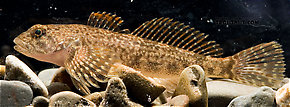 View 7 PicturesThis seems to be a mottled sculpin, Cottus bairdi. Normally this species is more mottled.
View 7 PicturesThis seems to be a mottled sculpin, Cottus bairdi. Normally this species is more mottled.
 View 7 PicturesThis seems to be a mottled sculpin, Cottus bairdi. Normally this species is more mottled.
View 7 PicturesThis seems to be a mottled sculpin, Cottus bairdi. Normally this species is more mottled.Collected May 6, 2007 from Mongaup Creek in New York
Added to Troutnut.com by Troutnut on May 18, 2007
Added to Troutnut.com by Troutnut on May 18, 2007
Stenonema femoratum (Cream Cahill) Mayfly Nymph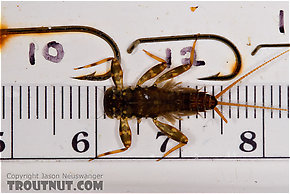 View 6 Pictures
View 6 Pictures
 View 6 Pictures
View 6 PicturesCollected May 6, 2007 from Mongaup Creek in New York
Added to Troutnut.com by Troutnut on May 18, 2007
Added to Troutnut.com by Troutnut on May 18, 2007
Lepidostoma (Little Brown Sedges) Little Brown Sedge Larva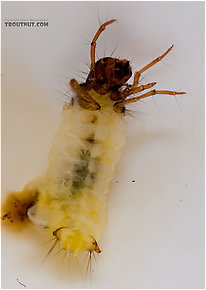 View 6 PicturesThis one got a little bit damaged in the abdomen when I extracted it from its case. That's a delicate job.
View 6 PicturesThis one got a little bit damaged in the abdomen when I extracted it from its case. That's a delicate job.
 View 6 PicturesThis one got a little bit damaged in the abdomen when I extracted it from its case. That's a delicate job.
View 6 PicturesThis one got a little bit damaged in the abdomen when I extracted it from its case. That's a delicate job.Collected May 6, 2007 from Mongaup Creek in New York
Added to Troutnut.com by Troutnut on May 18, 2007
Added to Troutnut.com by Troutnut on May 18, 2007
Stenochironomus poecilopterus Midge Adult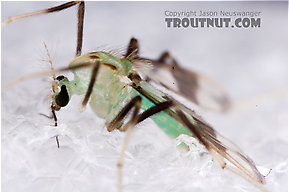 View 6 Pictures
View 6 Pictures
 View 6 Pictures
View 6 PicturesCollected May 6, 2007 from Mystery Creek #62 in New York
Added to Troutnut.com by Troutnut on May 18, 2007
Added to Troutnut.com by Troutnut on May 18, 2007
Neoleptophlebia Mayfly Nymph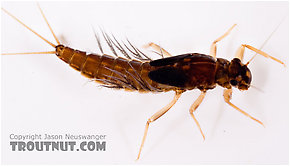 View 6 Pictures
View 6 Pictures
 View 6 Pictures
View 6 PicturesCollected May 6, 2007 from Mongaup Creek in New York
Added to Troutnut.com by Troutnut on May 18, 2007
Added to Troutnut.com by Troutnut on May 18, 2007
Baetisca obesa (Armored Mayfly) Mayfly Nymph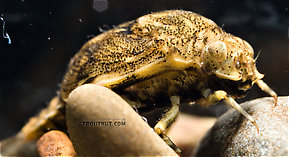 View 10 Pictures
View 10 Pictures
 View 10 Pictures
View 10 PicturesCollected May 6, 2007 from the Neversink River (above reservoir) in New York
Added to Troutnut.com by Troutnut on May 10, 2007
Added to Troutnut.com by Troutnut on May 10, 2007
Ephemerella aurivillii Mayfly Nymph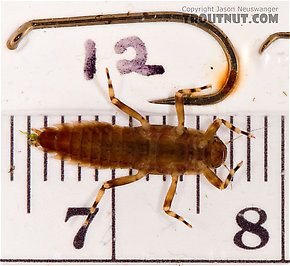 View 9 PicturesI'm pretty sure this is Ephemerella aurivillii. The body is 11mm long, which rules out most other species, and the hind legs seem to be more than 1.5 times longer than the fore legs -- a key characteristic for this species.
View 9 PicturesI'm pretty sure this is Ephemerella aurivillii. The body is 11mm long, which rules out most other species, and the hind legs seem to be more than 1.5 times longer than the fore legs -- a key characteristic for this species.
This specimen isn't in the best of shape, as it's missing all three tails, but it's the only one of its species I captured in this sample.
 View 9 PicturesI'm pretty sure this is Ephemerella aurivillii. The body is 11mm long, which rules out most other species, and the hind legs seem to be more than 1.5 times longer than the fore legs -- a key characteristic for this species.
View 9 PicturesI'm pretty sure this is Ephemerella aurivillii. The body is 11mm long, which rules out most other species, and the hind legs seem to be more than 1.5 times longer than the fore legs -- a key characteristic for this species.This specimen isn't in the best of shape, as it's missing all three tails, but it's the only one of its species I captured in this sample.
Collected May 6, 2007 from Mongaup Creek in New York
Added to Troutnut.com by Troutnut on May 18, 2007
Added to Troutnut.com by Troutnut on May 18, 2007
Eurylophella (Chocolate Duns) Mayfly Nymph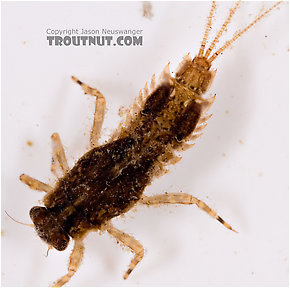 View 8 Pictures
View 8 Pictures
 View 8 Pictures
View 8 PicturesCollected May 6, 2007 from Mongaup Creek in New York
Added to Troutnut.com by Troutnut on May 18, 2007
Added to Troutnut.com by Troutnut on May 18, 2007
Rhyacophila carolina (Green Sedge) Caddisfly Larva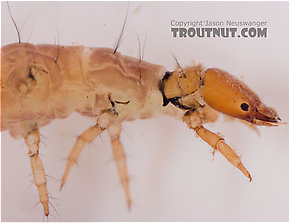 View 8 PicturesThis specimens shows that the name "green rockworm" doesn't quite fit all Rhyacophila larvae, even though it does fit the majority. This is actually the first of their larvae that I've found in a different color. I'm not sure if it's because of the species or because this is a young one, but I have found equally small green larvae, so I'm guessing it's the species.
View 8 PicturesThis specimens shows that the name "green rockworm" doesn't quite fit all Rhyacophila larvae, even though it does fit the majority. This is actually the first of their larvae that I've found in a different color. I'm not sure if it's because of the species or because this is a young one, but I have found equally small green larvae, so I'm guessing it's the species.
 View 8 PicturesThis specimens shows that the name "green rockworm" doesn't quite fit all Rhyacophila larvae, even though it does fit the majority. This is actually the first of their larvae that I've found in a different color. I'm not sure if it's because of the species or because this is a young one, but I have found equally small green larvae, so I'm guessing it's the species.
View 8 PicturesThis specimens shows that the name "green rockworm" doesn't quite fit all Rhyacophila larvae, even though it does fit the majority. This is actually the first of their larvae that I've found in a different color. I'm not sure if it's because of the species or because this is a young one, but I have found equally small green larvae, so I'm guessing it's the species.Collected May 6, 2007 from Mongaup Creek in New York
Added to Troutnut.com by Troutnut on May 18, 2007
Added to Troutnut.com by Troutnut on May 18, 2007
Neophylax (Autumn Mottled Sedges) Caddisfly Larva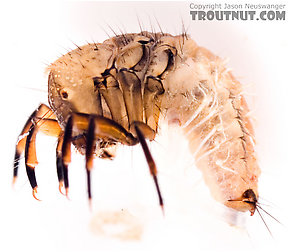 View 7 PicturesThe size of the head compared to the body in this larva is surprising, and I think this means it's a fairly early instar (Instar: Many invertebrates molt through dozens of progressively larger and better-developed stages as they grow. Each of these stages is known as an instar. Hard-bodied nymphs typically molt through more instars than soft-bodied larvae.) of something which is going to get a lot bigger, but I'm not sure.
View 7 PicturesThe size of the head compared to the body in this larva is surprising, and I think this means it's a fairly early instar (Instar: Many invertebrates molt through dozens of progressively larger and better-developed stages as they grow. Each of these stages is known as an instar. Hard-bodied nymphs typically molt through more instars than soft-bodied larvae.) of something which is going to get a lot bigger, but I'm not sure.
 View 7 PicturesThe size of the head compared to the body in this larva is surprising, and I think this means it's a fairly early instar (Instar: Many invertebrates molt through dozens of progressively larger and better-developed stages as they grow. Each of these stages is known as an instar. Hard-bodied nymphs typically molt through more instars than soft-bodied larvae.) of something which is going to get a lot bigger, but I'm not sure.
View 7 PicturesThe size of the head compared to the body in this larva is surprising, and I think this means it's a fairly early instar (Instar: Many invertebrates molt through dozens of progressively larger and better-developed stages as they grow. Each of these stages is known as an instar. Hard-bodied nymphs typically molt through more instars than soft-bodied larvae.) of something which is going to get a lot bigger, but I'm not sure.Collected May 6, 2007 from the Neversink River (above reservoir) in New York
Added to Troutnut.com by Troutnut on May 10, 2007
Added to Troutnut.com by Troutnut on May 10, 2007
Brachycentridae (Apple Caddis and Grannoms) Caddisfly Pupa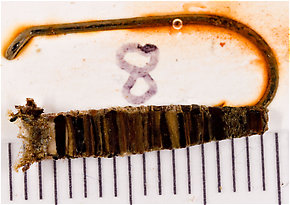 View 9 Pictures
View 9 Pictures
 View 9 Pictures
View 9 PicturesCollected May 6, 2007 from Mongaup Creek in New York
Added to Troutnut.com by Troutnut on May 18, 2007
Added to Troutnut.com by Troutnut on May 18, 2007
Ameletus (Brown Duns) Mayfly Nymph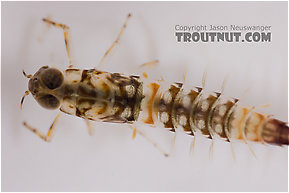 View 7 PicturesI think this is a pretty early instar (Instar: Many invertebrates molt through dozens of progressively larger and better-developed stages as they grow. Each of these stages is known as an instar. Hard-bodied nymphs typically molt through more instars than soft-bodied larvae.) Ameletus nymph. It's certainly a striking one.
View 7 PicturesI think this is a pretty early instar (Instar: Many invertebrates molt through dozens of progressively larger and better-developed stages as they grow. Each of these stages is known as an instar. Hard-bodied nymphs typically molt through more instars than soft-bodied larvae.) Ameletus nymph. It's certainly a striking one.
 View 7 PicturesI think this is a pretty early instar (Instar: Many invertebrates molt through dozens of progressively larger and better-developed stages as they grow. Each of these stages is known as an instar. Hard-bodied nymphs typically molt through more instars than soft-bodied larvae.) Ameletus nymph. It's certainly a striking one.
View 7 PicturesI think this is a pretty early instar (Instar: Many invertebrates molt through dozens of progressively larger and better-developed stages as they grow. Each of these stages is known as an instar. Hard-bodied nymphs typically molt through more instars than soft-bodied larvae.) Ameletus nymph. It's certainly a striking one.Collected May 6, 2007 from Mongaup Creek in New York
Added to Troutnut.com by Troutnut on May 18, 2007
Added to Troutnut.com by Troutnut on May 18, 2007
Male Paraleptophlebia (Blue Quills and Mahogany Duns) Mayfly Dun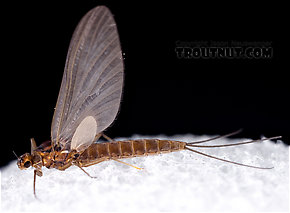 View 6 Pictures
View 6 Pictures
 View 6 Pictures
View 6 PicturesCollected May 6, 2007 from the Neversink River in New York
Added to Troutnut.com by Troutnut on May 10, 2007
Added to Troutnut.com by Troutnut on May 10, 2007
Hydropsychidae Caddisfly Larva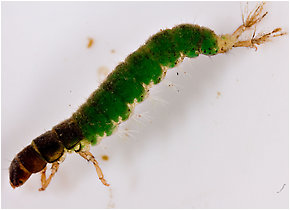 View 5 PicturesThis is one of the most vividly green Hydropsychidae larvae I've caught.
View 5 PicturesThis is one of the most vividly green Hydropsychidae larvae I've caught.
 View 5 PicturesThis is one of the most vividly green Hydropsychidae larvae I've caught.
View 5 PicturesThis is one of the most vividly green Hydropsychidae larvae I've caught.Collected May 6, 2007 from Mongaup Creek in New York
Added to Troutnut.com by Troutnut on May 18, 2007
Added to Troutnut.com by Troutnut on May 18, 2007
Ameletus ludens (Brown Dun) Mayfly Nymph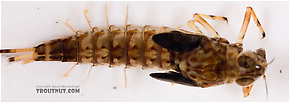 View 6 Pictures
View 6 Pictures
 View 6 Pictures
View 6 PicturesCollected May 6, 2007 from Mongaup Creek in New York
Added to Troutnut.com by Troutnut on May 18, 2007
Added to Troutnut.com by Troutnut on May 18, 2007
Rhyacophila (Green Sedges) Caddisfly Pupa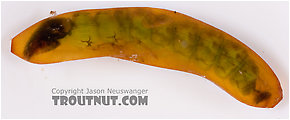 View 2 PicturesEven though I already have pictures of a Rhyacophila pupa in its cocoon, I took this one and then tried to keep the pupa alive, hoping to photograph it in several stages of development. That didn't work out; it seems to have died without changing much. Oh well.
View 2 PicturesEven though I already have pictures of a Rhyacophila pupa in its cocoon, I took this one and then tried to keep the pupa alive, hoping to photograph it in several stages of development. That didn't work out; it seems to have died without changing much. Oh well.
 View 2 PicturesEven though I already have pictures of a Rhyacophila pupa in its cocoon, I took this one and then tried to keep the pupa alive, hoping to photograph it in several stages of development. That didn't work out; it seems to have died without changing much. Oh well.
View 2 PicturesEven though I already have pictures of a Rhyacophila pupa in its cocoon, I took this one and then tried to keep the pupa alive, hoping to photograph it in several stages of development. That didn't work out; it seems to have died without changing much. Oh well.Collected May 6, 2007 from Mongaup Creek in New York
Added to Troutnut.com by Troutnut on May 18, 2007
Added to Troutnut.com by Troutnut on May 18, 2007
Most recent comments on this post (latest on top)
Comment on this post
Top 10 Fly Hatches
Top Gift Shop Designs
Eat mayflies.
Top Insect Specimens
Miscellaneous Sites
Troutnut.com is copyright © 2004-2024 Jason
Neuswanger (email Jason). See my FAQ for information about use of my images.
 privacy policy
privacy policy
